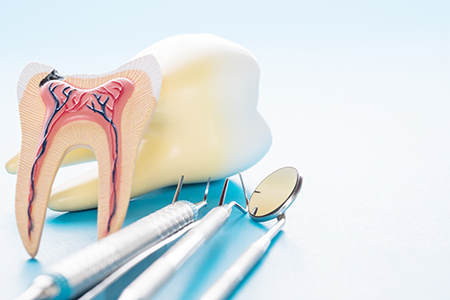
If your dentist tells you a tooth needs a root canal, there’s no reason to panic. Modern root canal therapy is a precise, conservative procedure designed to relieve pain, remove infection, and preserve your natural tooth. In many cases, having a root canal is a far better option than extraction when the goal is to maintain chewing function and the overall balance of your bite.
At the office of Suss Dental Group, we combine up-to-date technology with a patient-centered approach to deliver treatment that is as comfortable and efficient as possible. Our emphasis is on clear explanations, gentle care, and long-term results so you can make informed decisions about your oral health.
Keeping a natural tooth whenever feasible is usually the best path for your oral health. Natural teeth preserve the structure of your jaw, support adjacent teeth, and make chewing predictable and comfortable. When decay or trauma reaches the inner tissues of a tooth, root canal therapy removes the affected material but leaves the outer tooth intact for restoration.
Root canals are designed to stop the progression of infection while restoring the tooth’s function. After the internal work is complete, the tooth is typically rebuilt with a durable restoration — often a crown — that returns strength and protects against future damage. This conservative sequence helps preserve bone and prevents the shifting of surrounding teeth that can occur after extractions.
Thanks to advances in instruments, materials, and techniques, root canal treatment today is more reliable and predictable than ever. Most patients tolerate the procedure very well, and when performed carefully, treated teeth can remain functional for many years — often a lifetime — with proper care.

Each tooth contains a central chamber that houses the dental pulp — a network of connective tissue, blood vessels, and nerves that support development and provide sensation. When protective defenses are breached by deep decay, cracks, or traumatic injury, bacteria can reach these inner tissues and cause inflammation or infection.
Symptoms can vary. Some people experience sharp or lingering pain, sensitivity to hot or cold, or discomfort when biting. Others may notice a tooth darkening or localized swelling near the gumline. In some cases, the infection advances quietly and is first identified on routine X-rays as changes around the root tip.
Whether symptoms are dramatic or subtle, the underlying concern is the same: when the pulp is irreversibly damaged, infection can persist and spread, threatening the tooth and surrounding structures. Root canal therapy removes the source of infection while preserving what remains of the natural tooth.
Although not every toothache requires a root canal, the following warning signs commonly indicate pulpal involvement:
Pain that lingers, intensifies at night, or becomes difficult to manage often signals that the inner tissues are irritated or infected. Persistent tooth pain that disturbs sleep is a common cue to seek prompt dental evaluation.
Sharp, prolonged reactions to hot or cold foods and beverages can indicate an inflamed pulp. When temperature sensitivity persists beyond the expected momentary sensation, it may merit further assessment.
Pain when chewing or when the tooth is touched often suggests the inflammation has involved the root tissues or supporting bone. This type of discomfort can point to a deeper problem than surface decay.
A tooth that darkens after injury or over time can indicate that the internal tissues have changed. Discoloration alone isn’t diagnostic, but combined with other signs it can help guide the diagnosis.
Structural damage allows bacteria to travel into the deeper parts of the tooth. A crack that reaches the pulp can lead to persistent symptoms and often requires root canal therapy to save the remaining tooth.
Swelling in the gum tissues near a tooth or the presence of a draining lesion may indicate an abscess. These signs usually reflect an underlying infection that needs to be addressed promptly.
In advanced cases, infection can affect the bone that supports a tooth and lead to looseness. Treating the source of infection can halt progression and allow healing to begin.

Diagnosing and treating a tooth problem before it becomes more extensive helps protect surrounding structures and reduces the likelihood of complex intervention later. A timely root canal often restores comfort quickly and limits the spread of infection to adjacent teeth or bone.
Routine oral exams and digital X-rays can reveal issues that haven’t yet produced pain. Detecting disease in an early stage gives you more conservative treatment options and better long-term outcomes. Even when symptoms are present, prompt care tends to increase the chances of saving the tooth.
Delaying treatment can allow infection to progress, increasing the risk of more widespread symptoms and more invasive procedures. Acting quickly keeps options open and supports a more predictable recovery.
Root canal therapy is designed to remove inflamed or infected pulp tissue, clean and shape the internal canals, and seal them to prevent reinfection. The process typically begins with local anesthesia to keep you comfortable; modern anesthetics and techniques make the procedure manageable for most patients.
Depending on the tooth’s anatomy and the presence of infection, treatment may be completed in a single visit or require two or more appointments. Your clinician will tailor the approach to the tooth’s needs — some molars have multiple complex canals, while front teeth generally have a more straightforward anatomy.
Following cleaning and disinfection, the canals are filled with a biocompatible material that seals the space. In many cases, a temporary filling is placed initially, and a durable restoration such as a crown is recommended afterward to restore strength and protect the tooth from fracture. For patients who experience anxiety, sedation dentistry options are available and can be discussed during your consultation.

Comfort and follow-up care are central to a successful outcome. Immediately after the appointment you may feel numbness until the anesthesia wears off, and it’s wise to avoid chewing until sensation returns to prevent accidental injury to soft tissues.
Mild to moderate soreness around the treated tooth is common for a few days as tissues heal. Over-the-counter pain relievers usually manage this discomfort, and your provider will advise on the safest options for you. If antibiotics are prescribed to address an infection, it’s important to complete the full course as directed.
While a temporary filling protects the tooth between appointments, the treated tooth is more vulnerable to fracture until a permanent restoration is placed. Your dentist will recommend an appropriate timeline for placing a crown or other definitive restoration; following that advice helps ensure the tooth’s longevity.
Avoid hard or sticky foods on the treated side until a permanent restoration is in place. Maintain gentle, thorough oral hygiene to support healing and reduce the risk of further problems.
Call your dental provider if you experience increasing pain, persistent swelling, fever, or any unusual symptoms after treatment. Prompt attention can prevent complications and keep the recovery on track.
With proper restoration and regular dental care, teeth that have had root canal therapy can remain healthy and functional for many years. Routine checkups and good oral hygiene are key to preserving the result.
At Suss Dental Group, we focus on providing thorough explanations and careful treatment so patients understand their options and feel comfortable with the plan. Our goal is to relieve pain, eliminate infection, and restore function while protecting your natural tooth whenever appropriate.
If you have questions about root canal therapy, symptoms you’re experiencing, or what to expect from treatment, please contact us for more information and guidance. We’re here to help you make an informed choice about your dental care.

A root canal procedure is the best way to save a tooth that has been damaged by decay or injury and preserve your natural smile. The alternative is an extraction and treatment to replace the tooth. While at times a tooth is non-restorable and an extraction is the only option, when possible, it’s best to try and save your natural tooth. With proper care, a tooth with root canal therapy can serve your smile well for many years to come.
Despite lingering myths from before the age of modern dental anesthesia and technology, having a root canal procedure today is as routine and comfortable as visiting the dentist for a filling. While the procedure is performed under local anesthesia with your tooth completely numbed, we can also discuss options in dental sedation.
Whether the symptoms of a dental infection subside after a course of antibiotics, a draining abscess provides you with some temporary pain relief, or a tooth with radiographic evidence of pathology has not yet developed symptoms, it’s essential, before an infection worsens or occurs, to have a root canal procedure performed. In this way, the tooth can be disinfected, filled, and sealed to protect your health and avoid further problems.
If you have sustained a dental injury, have a toothache, jaw pain, swelling, or are experiencing any other unusual and uncomfortable oral symptoms, contact our office immediately for care. Dental problems that have not been evaluated and treated can significantly worsen, producing more severe damage and consequences for the involved teeth, your oral health, and even your overall wellbeing. Once you get in touch with our office, our friendly and compassionate office team will get you in for care at your earliest convenience.
While some root canal procedures can be completed in one visit, others may involve 2 or 3 appointments. How long it takes depends on various factors, including active infection, the number of canals in the tooth, and the tooth’s location or anatomy.
With a success rate that exceeds 95%, root canal therapy remains the most effective procedure to save a tooth in which the inner vital tissues have been damaged. However, as with all healthcare procedures, there are a small percentage of cases where the teeth become symptomatic a second time. The good news is that many of these teeth can still be saved with root canal retreatment or a minor surgical procedure known as an apicoectomy.
The best ways to maintain a tooth with root canal therapy are to get the proper restoration required to rebuild and protect the tooth, maintain proper oral hygiene, and schedule appointments for routine dental checkups and care.
Saving a tooth with root canal therapy is a wise investment that, in the long run, is typically less costly and invasive than having the tooth extracted and replaced with a fixed bridge or implant. As far as the exact cost of care, it can vary depending on which tooth is being treated. Many dental insurance plans provide coverage for root canal therapy. At the office of Suss Dental Group, we do our best to optimize your dental benefits and minimize your out-of-pocket expenses. Our staff will answer all your questions about the cost of care and discuss all your payment options.
At the office of Suss Dental Group, we use the latest technology and most effective methods of care to provide precise and gentle care. Our reputation for excellence is based upon a consistent record of achieving successful treatment outcomes while providing prompt, stress-free, and convenient treatment for every type of dental need.
A root canal is a dental procedure that removes inflamed or infected pulp from inside a tooth to relieve pain and stop the spread of infection. The treatment preserves most of the natural tooth structure while eliminating the source of pain and disease. After cleaning and sealing the internal canals, the tooth is restored to function with a permanent filling or crown.
You may need a root canal when decay, a deep crack, or traumatic injury reaches the pulp and causes persistent symptoms or radiographic signs of infection. Common reasons include lingering sensitivity to heat or cold, severe or throbbing pain, swelling, or a darkened tooth. Diagnosis combines a clinical exam, pulp testing and digital X-rays to determine whether the pulp can be saved or requires treatment, and the team at Suss Dental Group in Bergenfield can evaluate your tooth and explain the best options.
Root canal therapy preserves the outer tooth by removing damaged pulp while leaving the tooth’s hard structure intact, which helps maintain normal chewing function and bite alignment. Saving a natural tooth prevents the shifting of adjacent teeth and helps preserve the jawbone in ways that replacements cannot fully replicate. Because the procedure targets only the diseased tissues, it is a conservative alternative to extraction when preservation is feasible.
Following the internal treatment, a durable restoration such as a crown is commonly placed to restore strength and prevent fracture under chewing forces. Modern materials and techniques allow restored teeth to function for many years with proper care and routine dental visits. Your dentist will recommend the appropriate timing and type of restoration based on the tooth’s location and remaining structure.
Symptoms that commonly indicate pulpal involvement include ongoing or severe tooth pain, heightened sensitivity to hot or cold, and discomfort when biting or tapping the tooth. Swelling of the gum, a draining lesion near the tooth, or a tooth that has darkened after injury are additional warning signs. Some infections progress without noticeable pain and are first seen on routine digital X-rays as changes around the root tip. Because symptoms vary, any persistent change in the way a tooth feels should prompt evaluation.
Your dentist will use a combination of clinical examination, percussion and sensitivity testing, and radiographic imaging to determine whether a root canal is necessary. Tests help differentiate between reversible sensitivity and irreversible pulpitis that requires treatment. Early diagnosis increases the chances of saving the tooth and reduces the need for more extensive procedures later.
A typical root canal begins with local anesthesia to numb the tooth and surrounding tissues, followed by an access opening through the crown to reach the pulp chamber. Specialized instruments are used to remove the inflamed or infected tissue, clean and shape the root canals, and disinfect the internal spaces. After that, the canals are filled with a biocompatible material and sealed to prevent reinfection. A temporary restoration may be placed until a permanent crown or filling can be completed.
Treatment may be completed in a single visit for straightforward cases, but some teeth require two or more appointments when anatomy is complex or infection needs time to resolve. Molars with multiple canals often take longer than front teeth that have simpler anatomy. Appointment length varies, but patients should plan for at least an hour and possibly longer for multi-visit therapy.
Most patients experience minimal discomfort during the procedure because modern local anesthetics and technique provide effective pain control. Dentists can also offer sedation options for patients with anxiety to make the experience more comfortable and manageable. Open communication about medical history and concerns helps your clinician choose the safest anesthesia or sedation approach. If you have questions about sedation, discuss options before your appointment so the team can prepare appropriately.
After treatment, mild to moderate soreness is common for a few days and is usually controlled with over-the-counter analgesics and rest. Severe or increasing pain, fever, or persistent swelling should prompt a call to your dental provider. Following post-op instructions, including avoiding hard foods and maintaining good oral hygiene, helps speed recovery.
As with any procedure, root canal therapy carries small risks such as persistent infection, incomplete cleaning of complex canals, or fracture of a weakened tooth. Rare complications can include separation of an instrument inside a canal or an unusual reaction to materials used. Most complications are manageable when identified early through follow-up care and radiographic monitoring.
Your dentist will explain the potential risks and benefits for your specific tooth and use diagnostic tools to reduce uncertainty before treatment begins. Referral to an endodontist may be recommended for teeth with unusual anatomy or when previous treatment has failed. Informed consent and a clear aftercare plan help ensure the safest possible outcome.
Immediately after a root canal you may be numb for a few hours and should avoid chewing until sensation returns to prevent accidental injury to soft tissues. Mild soreness around the treated tooth is normal for several days as surrounding tissues heal and inflammation subsides. Keeping the area clean with gentle brushing and flossing supports healing and reduces the risk of further problems. If antibiotics are prescribed, complete the entire course as directed to address any existing infection.
A permanent restoration such as a crown is typically recommended soon after root canal therapy to protect the tooth from fracture and restore full function. Your dentist will advise on the optimal timeline and materials based on the tooth’s location, remaining structure, and bite. Our team at Suss Dental Group will schedule appropriate follow-up visits and answer questions about long-term care.
Teeth that have had root canals are more brittle because the internal tissues that once nourished the tooth are removed, making a protective restoration important for longevity. Crowns are commonly recommended for posterior teeth because they encase the remaining tooth structure and distribute chewing forces. For front teeth, a well-placed filling or a veneer may be suitable depending on the extent of damage and esthetic needs.
The choice of restoration depends on tooth position, how much natural tooth remains, and your functional demands; your dentist will discuss the best option for a durable result. Properly fitted restorations also help prevent recurrent decay that could compromise the treated tooth. Routine dental visits and good oral hygiene are essential to monitor the restoration and the health of the surrounding tissues.
Root canal treatment can sometimes fail if bacteria persist in untreated portions of the canal system, if new decay allows reinfection, or if the tooth develops a fracture. Symptoms of failure may include return of pain, swelling, or radiographic evidence of persistent disease near the root tip. Early detection through follow-up exams improves the success of corrective treatments.
When a treated tooth fails, options include nonsurgical retreatment, surgical procedures such as an apicoectomy, or extraction with appropriate replacement planning. The best course depends on the tooth’s restorability, the patient’s overall health, and long-term prognosis. Your dentist can review the findings and coordinate care with a specialist if retreatment or surgery offers a better chance to save the tooth.
Preventing the need for a root canal begins with diligent oral hygiene: brush twice daily with fluoride toothpaste, floss daily, and maintain regular professional cleanings. Prompt attention to cavities, chips, or cracks reduces the chance that bacteria will reach the pulp and cause infection. Mouthguards for sports and addressing bruxism with night guards can also protect teeth from trauma that leads to pulp damage.
Regular dental exams with digital X-rays allow early detection of problems before they progress to irreversible pulpitis. Timely treatment of decay and careful monitoring of suspicious teeth preserve options and often avoid more invasive care. If you experience persistent tooth pain or any of the warning signs described earlier, contact your dental provider promptly for evaluation.

Ready to schedule your next dental appointment or have questions about our services?
Contacting Suss Dental Group is easy! Our friendly staff is available to assist you with scheduling appointments, answering inquiries about treatment options, and addressing any concerns you may have. Whether you prefer to give us a call, send us an email, or fill out our convenient online contact form, we're here to help. Don't wait to take the first step towards achieving the smile of your dreams – reach out to us today and discover the difference personalized dental care can make.